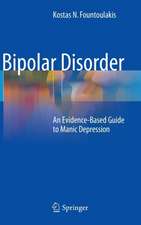Bipolar Disorder in Older Age Patients
Editat de Susan W. Lehmann, Brent P. Foresteren Limba Engleză Hardback – 12 ian 2017
Bipolar Disorder in Older Age Patients will be an ideal update for the practicing community or geriatric psychiat
rist working with older patients with bipolar disorder.| Toate formatele și edițiile | Preț | Express |
|---|---|---|
| Paperback (1) | 776.41 lei 6-8 săpt. | |
| Springer International Publishing – 7 iul 2018 | 776.41 lei 6-8 săpt. | |
| Hardback (1) | 846.49 lei 6-8 săpt. | |
| Springer International Publishing – 12 ian 2017 | 846.49 lei 6-8 săpt. |
Preț: 846.49 lei
Preț vechi: 891.04 lei
-5% Nou
Puncte Express: 1270
Preț estimativ în valută:
161.97€ • 169.13$ • 133.75£
161.97€ • 169.13$ • 133.75£
Carte tipărită la comandă
Livrare economică 15-29 aprilie
Preluare comenzi: 021 569.72.76
Specificații
ISBN-13: 9783319489100
ISBN-10: 3319489100
Pagini: 421
Ilustrații: XIV, 238 p. 5 illus. in color.
Dimensiuni: 155 x 235 x 16 mm
Greutate: 0.53 kg
Ediția:1st ed. 2017
Editura: Springer International Publishing
Colecția Springer
Locul publicării:Cham, Switzerland
ISBN-10: 3319489100
Pagini: 421
Ilustrații: XIV, 238 p. 5 illus. in color.
Dimensiuni: 155 x 235 x 16 mm
Greutate: 0.53 kg
Ediția:1st ed. 2017
Editura: Springer International Publishing
Colecția Springer
Locul publicării:Cham, Switzerland
Cuprins
Part I: Introduction, Overview and Epidemiology: Definition, what is late-life bipolar disorder, what is known about demographics.- Distinguishing late-onset vs early- onset bipolar disorder.- Bipolar 1 vs bipolar 2 disorder.- Natural history and course of illness, including morbidity, use of psychiatric and medical services.- Part II: The Clinical Assessment: Differential diagnosis, including distinguishing late-life bipolar disorder from frontotemporal dementia and from disinhibition syndromes due to neurologic disease and from secondary mania due to medications.- Aspects about the clinical interview, aspects to address in obtaining relevant history from patients and families, useful psychometric scales for office use, risk assessment, cognitive assessment.- Comorbidities: medical comorbidities, psychiatric comorbidities, including anxiety disorders and substance use disorders and their impact on clinical course.- Part III: Neurobiology of late-life bipolar disorder: findings from current research.- Neuroimaging findings.- Neuroprogression.- Biomarker and oxidative stress, mitochondrial distress/dysfunction.- Neurocognitive research.- Part IV: Principles of management: Overview: Acute and Maintenance treatment, Risk for suicide, Coordination with other treating physicians , Medication adherence and risk of relapse.- Pharmacotherapy: Mania.- Pharmacotherapy: Bipolar depression.- Pharmacology: rapid cycling, mixed episodes.- Pharmacotherapy: best practices for maintenance treatment.- Lithium: overview of effects on the kidney, both acute and long-term; impact of lithium on endocrine disease (e.g. diabetes insipidus, hypercalcemia and hyperparathyroidism).- ECT: what is its role for late-life bipolar disorder.- Cognitive impairment, dementia and late-life bipolar disorder.- Psychotherapy and psychosocial interventions, family psychoeducation and support.-Treatment settings: inpatient, partial hospitalization, outpatient, models of integrated care.- Part V: Future directions: Future directions, future research, and anticipated future needs for this population of patients.
Recenzii
“This book is concise and accessible to the generalist, yet it also provides scientific insights and clinically useful advice to the specialist along with a number of interesting diversions into less-frequented subjects.” (James W. Herron, The British Journal of Psychiatry, Vol. 213 (1), July, 2018)
“This is a comprehensive review of current research regarding the evaluation and management of older adults suffering from bipolar disorder. … It is intended for general psychiatrists caring for older adults with bipolar disorder. It is also relevant for all gerontologists, residents, medical students, and health care providers and policy makers involved in the creation of programs and treatment of this patient population. … Each chapter includes clinical vignettes, learning points, and clinical pearls to illustrate the principles.” (Michael Easton, Doody’s Book Reviews, June, 2017)
“This is a comprehensive review of current research regarding the evaluation and management of older adults suffering from bipolar disorder. … It is intended for general psychiatrists caring for older adults with bipolar disorder. It is also relevant for all gerontologists, residents, medical students, and health care providers and policy makers involved in the creation of programs and treatment of this patient population. … Each chapter includes clinical vignettes, learning points, and clinical pearls to illustrate the principles.” (Michael Easton, Doody’s Book Reviews, June, 2017)
Notă biografică
Susan W. Lehmann, MD
Associate Professor
Johns Hopkins University School of Medicine
Department of Psychiatry and Behavioral Sciences
Baltimore, MD
USA
Brent P. Forester, MD, MSc
Chief, Division of Geriatric Psychiatry, McLean Hospital, Belmont, MA
Medical Director, Behavioral Health Integration, Center for Population Health, Partners Healthcare, Boston, MA
Assistant Professor of Psychiatry, Harvard Medical School, Boston, MA
USA
Caracteristici
Explains the aspects of aging that impact the diagnosis, clinical course, and treatment of bipolar disorder Describes differences in the illness and its management in the elderly Includes clinical case vignettes and “clinical pearls” that will assist the clinician Includes supplementary material: sn.pub/extras












